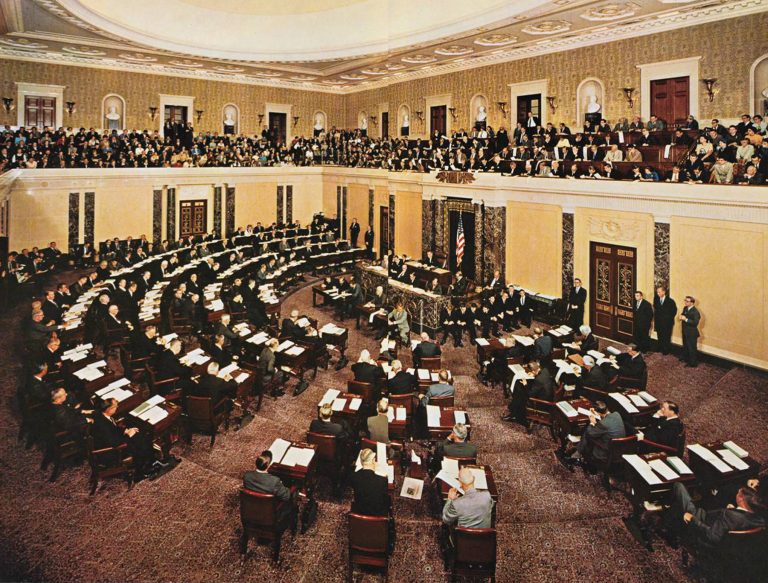In recent months, polling data have shown a notable shift in American public opinion regarding the overall direction of the United States, with a growing percentage of voters expressing optimism about the country’s path. This change comes amid the administration of President Donald Trump and marks a significant departure from previous years’ sentiments.
The Pulse of the Nation: Right Direction vs. Wrong Track
For over two decades, polling firms have tracked a simple but telling question: Is the United States headed in the “right direction” or the “wrong track”? This metric has often served as a barometer of national mood, capturing the electorate’s general optimism or pessimism about the country’s future.
According to Rasmussen Reports, a polling organization known for its daily tracking polls, a survey conducted in late May 2025 indicated that approximately 48% of Americans believed the country was headed in the right direction. This figure represents the highest percentage recorded by Rasmussen since it began polling on this question in 2006. Meanwhile, 47% believed the country was on the wrong track, with the remaining 5% undecided.
While 48% does not constitute an outright majority, Rasmussen highlighted that a rolling average over a five-day period reached 50%, marking a symbolic milestone. This milestone has been described as “uncharted territory” in the pollster’s reporting history.
Context and Historical Comparison
To appreciate the significance of these numbers, it helps to consider the historical context. Throughout much of the 2010s and early 2020s, the “wrong track” response generally dominated, often by large margins. For example, during the final months of the Biden administration’s first term, Rasmussen and other polling firms consistently showed that fewer than 40% of Americans felt the country was headed in the right direction, with many polls reporting a majority or large plurality saying the opposite.
Similarly, RealClearPolitics’ aggregated polling data showed that in November 2024, just 26% of respondents said the country was on the right track, while 63% felt it was on the wrong track. This represented a 37-point gap—a substantial indication of national pessimism at that time.
By mid-2025, however, the gap between “right direction” and “wrong track” respondents had narrowed significantly, with some polls showing the difference shrinking to single digits. This swing suggests an improvement in national sentiment, with growing numbers of voters expressing hopefulness or approval of current policies.
Interpreting the Shift
Why might public optimism have increased? Several factors likely contribute:
-
Economic Indicators: Early 2025 saw reports of economic growth, job creation, and investment in American industries. Such developments can influence public opinion by improving perceptions of personal and national financial stability.
-
Policy Changes: The Trump administration has emphasized deregulation, tax reform, and reshoring of manufacturing jobs. Supporters argue these measures are revitalizing the economy, which could boost the public’s sense that the country is on the right path.
-
Geopolitical Developments: Some voters may view shifts in foreign policy, such as trade agreements or diplomatic initiatives, as signs of renewed American leadership.
-
Media and Political Narratives: Public sentiment is also shaped by media coverage, political messaging, and social discourse. Positive portrayals of the administration’s successes can sway undecided or moderately optimistic voters.
Critiques and Cautions
Despite the positive spin on these numbers, there are important caveats:
-
Margin of Error and Sampling Differences: Poll results vary based on methodology, sample size, and question wording. Rasmussen’s results, while influential, have faced criticism for potential partisan leanings. Other pollsters may report different numbers.
-
“Right Direction” vs. Majority Support: The fact that 48% or even 50% feel the country is on the right track does not necessarily translate into overwhelming endorsement of all policies or broad political support. It is a measure of general sentiment rather than detailed policy approval.
-
Political Polarization: The U.S. remains highly polarized. Optimism about the country’s direction often correlates strongly with political affiliation. For example, Republican voters tend to report higher “right direction” figures under a Republican administration, while Democrats often express the opposite.
-
Long-Term Trends: While a short-term rise in optimism is notable, sustaining such sentiment over time depends on continued economic performance, policy success, and external factors like international stability or domestic crises.
Voices from the Ground
Pollsters and analysts alike have remarked on the unusual nature of this sentiment shift. Mark Mitchell of Rasmussen described the moment as unprecedented in the poll’s 20-year history. “I don’t think the Republican Party fully appreciates the significance of this moment,” he remarked in interviews. “It represents a rare opportunity to build on growing public confidence.”
Meanwhile, President Trump has touted the data as validation of his administration’s agenda. On social media platforms, he celebrated what he called “one of the greatest and fastest comebacks in history,” citing economic investments and growth figures. His supporters view these developments as the beginning of a “golden age” for America.
What the Numbers Mean for the Future
The growing public optimism could have several political implications:
-
Upcoming Elections: Higher approval of the country’s direction may bolster the Republican Party’s chances in upcoming midterm or local elections. Positive sentiment often correlates with voter turnout and support for the incumbent party.
-
Policy Momentum: The administration may leverage improved public mood to push through legislative priorities, arguing that the public is receptive to their agenda.
-
Opposition Strategy: Democrats and critics may need to recalibrate their messaging to address rising optimism and counter narratives of progress under Trump.
However, political analysts caution against complacency. Sentiment can be fragile and influenced by unforeseen events such as economic downturns, international conflicts, or domestic controversies.
Conclusion
The latest polling data reveal a notable shift in American public opinion regarding the nation’s trajectory, with close to half of respondents now believing the country is on the right track. This shift is significant given decades of pessimism and reflects changing perceptions amid the Trump administration’s policies and the broader economic and political environment.
While these numbers provide reasons for optimism, they also invite careful scrutiny and recognition of the country’s continuing divisions and challenges. Whether this trend signals a sustained improvement in national mood or a temporary fluctuation remains to be seen.
As the United States navigates a complex political landscape, the voices of its citizens—captured through polls and surveys—offer a valuable snapshot of collective hopes, concerns, and expectations for the road ahead.

James Jenkins is a celebrated Pulitzer Prize-winning author whose work has reshaped the way readers think about social justice and human rights in America. Raised in Atlanta, Georgia, James grew up in a community that instilled in him both resilience and a strong sense of responsibility toward others. After studying political science and creative writing at Howard University, he worked as a journalist covering civil rights issues before dedicating himself fully to fiction. His novels are known for their sharp, empathetic portraits of marginalized communities and for weaving personal stories with broader political realities. Jenkins’s breakout novel, Shadows of Freedom, won national acclaim for its unflinching look at systemic inequality, while his more recent works explore themes of identity, resilience, and the fight for dignity in the face of oppression. Beyond his novels, James is an active public speaker, lecturing at universities and participating in nonprofit initiatives that support literacy and community empowerment. He believes that storytelling is a way to preserve history and inspire change. When not writing, James enjoys jazz music, mentoring young writers, and traveling with his family to explore cultures and stories around the world.









